The Weekly Watch
Coral Chorale
Today I would like to sing the praise of coral and lament it's rapid demise. I'm in Key West hoping to see a reef or two. I've been fortunate to visit the second largest reef system, the Mesoamerican reef, but this is my first visit to the keys. We were invited by a friend whose relatives have a house there which they are not renting out this month. So let's dive in and see what we can find under the surface of things.

Corals are found across the world’s ocean, in both shallow and deep water, but reef-building corals are only found in shallow tropical and subtropical waters. This is because the algae found in their tissues need light for photosynthesis and they prefer water temperatures between 70-85°F (22-29°C). There are also deep-sea corals that thrive in cold, dark water at depths of up to 20,000 feet (6,000 m). Both stony corals and soft corals can be found in the deep sea. Deep-sea corals do not have the same algae and do not need sunlight or warm water to survive, but they also grow very slowly.
This map provides a view of both the Mesoamerican and the reef system of the Keys and Cuba.

I live on the edge of a reef of the past, and find fossils of ancient solitary horn corals as well as early colonies. On the other side of the mountain are the corals...both solitary and colonial. The crinoid forests built the limestone on my side. In between are the shale deposit of a calm ancient sea and the sandy deposits of a delta and shoreline system....all geologically frozen in time. Corals have a long history on our planet, and have grown, retreated, and disappeared for literally millions of years.
http://globalreefproject.com/coral-reef-history.php
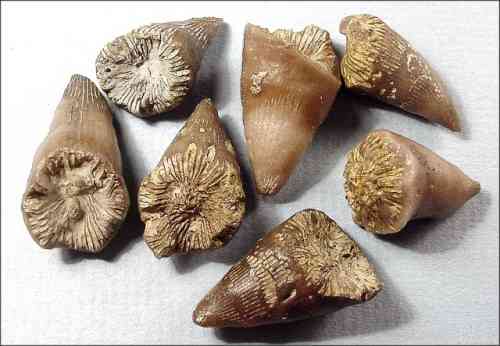

Corals are remarkable animals, capable of creating vast structures. Corals are living colonies of tiny tube-like animals called polyps - the individuals of some species are just 3mm long. Each polyp has a mouth surrounded by tentacles, usually arranged with six-fold symmetry.
The polyps produce a hard outer skeleton made of calcium carbonate, each laying down a hexagon-shaped foundation. This grows by up to 10 centimetres a year and the coral develops into various shapes and sizes, depending on the species.
Together with coralline algae and other groups that produce limestone skeletons, corals gradually build up the complex three-dimensional structure of a reef. (2 min)
Animated explanation of the importance of these small creatures
https://www.youtube.com/watch?v=eNqbSi_6KdA (2.2 min)
There are several species of corals in the Keys
https://www.floridamuseum.ufl.edu/southflorida/habitats/corals/species-p...
The Florida Keys encompass a loose string of 822 islands scattered from Biscayne Bay just south of Miami to the Dry Tortugas, about 200 miles to the southwest. Thirty-two of the islands are inhabited and a few, like Key Largo, Islamorada, Marathon, and Key West, are heavily developed for tourism.
These islands were referred to as "cayos" by the early Spanish travelers and map makers. The English generally used the word "kay" or "cay" for small islands. Somehow this became "Key" for us Americans.
From Soldier Key southward are the non sedimentary Keys classified as High Coral Keys, Low Coral Keys and the Oolite Keys. There is not a clear dividing line but the Upper and Middle Keys are of Key Largo Limestone which are the peaks of once live coral forests. These were once live, thriving and dense forests of many corals and other marine organisms - flora and fauna. As one would expect the coral forests were of various densities and heights; however, they are of less height the farther south one goes except for Key West. These have heights from 10 to 18 feet. The Low Coral Keys are from five to 10 feet. As the glaciers reformed taking water from the ocean, sea level dropped, the coral forests died and collapsed into islands we now live on.
http://www.keyshistory.org/keysgeology.html
So the lower keys are coral deposits.
Here's some nice shots of some fish and reefs along the Keys
http://www.keyshistory.org/reef-Patch.html
Here's a few shots from the mesoamerican reef along Mexico's coast...

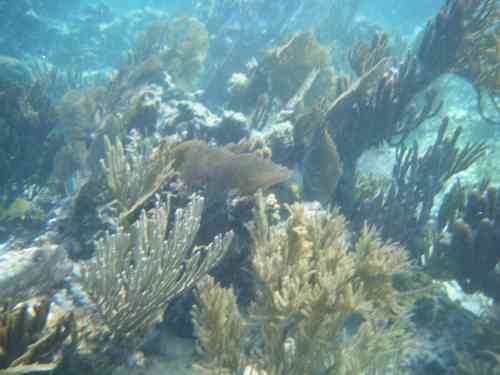
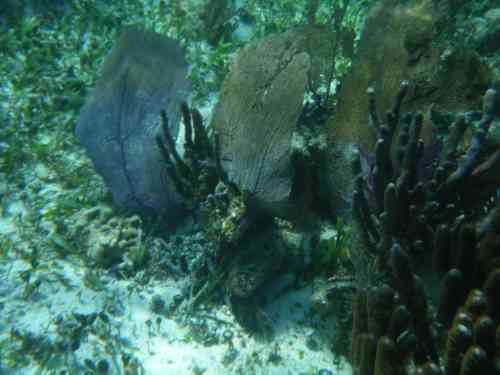
The reef system is more than just the coral animals - it is an extensive ecosystem. Reefs are habitable architecture that provides shelter and food for a quarter of all marine life. It also protects millions of people living in coastal communities as well as mangrove and seagrass environments (which are important nursery habitats for fish) by diffusing wave energy by up to 97 per cent.
http://www.nhm.ac.uk/discover/coral-reef-builders.html
https://ocean.si.edu/ocean-life/invertebrates/corals-and-coral-reefs
Here's a time lapse of a reef which makes it obvious it is a living system (2 min)
The corals and reef system are most active at night (1 min)
https://www.youtube.com/watch?v=GS0I0nJWWac
Here's a cool 9 min video of a Red Sea reef at night using fluorescence to distinguish between living and dead coral https://www.youtube.com/watch?v=nLMAyYHNeeQ
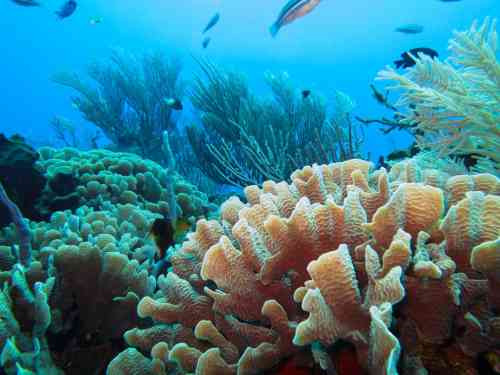
As I'm sure you know these important ecosystems are at risk. The greatest threats to reefs are rising water temperatures and ocean acidification linked to rising carbon dioxide levels. High water temperatures cause corals to lose the microscopic algae that produce the food corals need—a condition known as coral bleaching. Severe or prolonged bleaching can kill coral colonies or leave them vulnerable to other threats. Meanwhile, ocean acidification means more acidic seawater, which makes it more difficult for corals to build their calcium carbonate skeletons. And if acidification gets severe enough, it could even break apart the existing skeletons that already provide the structure for reefs.
In 2016 30% of the great barrier reef died and bleached. In the documentary “Chasing Coral,” a team of photographers, divers and scientists analyze more than 650 hours of underwater footage to illustrate the real-time effects warming seas. Jeff Orlowski, the director of the film, talks about the challenges of showing these rarely-seen effects of climate change.
https://www.youtube.com/watch?v=8eFTkeUYpfQ (6 min)
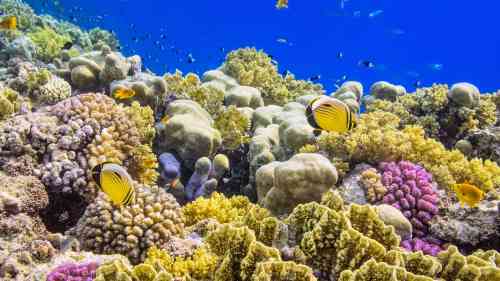
They still look beautiful, but coral reefs are dying at staggering rates — experts project that 90 percent of the world's reefs will be gone by 2050. But a growing group of scientists around the world are searching for innovative solutions to make sure that doesn't happen. Coral reefs are among the earth’s most precious natural resources. They harbor a million species and provide food for 500 million people around the world. But warming waters, pollution and overfishing have badly damaged these precious ecosystems; roughly 50 percent of the world’s corals have been lost in just the last 30 years. “The rates of change in our environment are far outpacing the intrinsic capacity of coral reefs to survive.” said Dr. Ruth Gates, the Director of the Hawaii Institute of Marine Biology, where she is pioneering research that could help corals survive. “If we don’t mitigate at all, coral reefs will not be the things we’re worrying about, it will be the survival of our species.” Dr. Gates is just one of the scientists devising innovative ways to take coral reef restoration into their own hands. Her lab has started to breed and distribute, "super coral" — the strongest breeds of coral that can thrive in warmer environments. And in Curaçao, a small coral rich island in the Caribbean Sea, a team of scientists are finalizing a technology that could distribute fertilized coral eggs across the ocean, repopulating reefs worldwide. Can we save and rebuild coral reefs?
https://www.youtube.com/watch?v=hOsZOpp6x4c (14 min)
Another possible way to help coral survive - Dr. David Vaughan in the FL keys has developed a game-changing technique called “microfragmenting” that allows corals to grow more than 25 times faster than normal, which could restore the dwindling population of healthy coral reefs. https://www.youtube.com/watch?v=qHKpcnn5Tws (8 min)
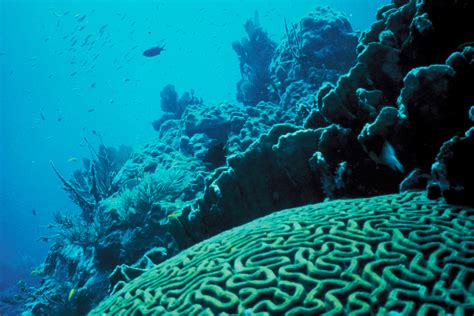
We made it back home last night. Reflecting on disappearing natural systems also make me think about the fate of our species. We as a society just don't understand our connection to nature. Rather we think we lord over the Earth. This attitude may well spell our demise.
We are mostly seawater...a species which is merely a drop in the ocean of life. Yet we are driving the biosphere into a new realm. The oceans from which we came tell the story if we would listen to the story...not history but her story...the mother Earth. I hope you enjoyed this look at another disappearing biome...coral reefs.


Comments
Good morning Weekly Watchers ...
It's depressing watching the natural world die because we were stupid; the reefs, the butterflies, the vaquitas and so many more. When I see those nature shows on PBS I'm reminded of the movie Soylent Green where they would show people scenes of a world that no longer exists as they check out.
Here's a vid about that tribe that killed a "missionary": YouTube, 10 min.
Lori Wallach spoke at a forum on Market Fundamentalism. She says there are some good parts in the new NAFTA deal: YouTube, 21 min.
I never was much of a Pink Floyd fan, the music was too clean, not enough funk, but Roger Waters is well-informed on economics. If you have to get your politics from a musician Waters is much better than that neoliberal Boner guy who goes to Davos. Here is a two-part interview with TRNN, Neoliberalism Is Fueling the Flames of Fascism: Part 1, 13 min., Part 2, 16 min.
Have a nice day.
We wanted decent healthcare, a living wage and free college.
The Democrats gave us Biden and war instead.
Hey
Thanks for the links. I was without news all week, and just now catching up. Jimmy had some good pieces this week I just caught.
We need to enjoy the biosphere while we can.
Thanks for dropping by!
“Until justice rolls down like water and righteousness like a mighty stream.”
Welcome home lo
Funny how it’s possible to see so much beauty and at the same time see that which we live so much dis - integrate before our very eyes. The monarch preserve behind my house only had a few monarchs this summer. They are in danger now. That piece of news was so hard for me to read.
Thank you for the ot.
Stop Climate Change Silence - Start the Conversation
Hot Air Website, Twitter, Facebook
our monarch population...
along with so many other butterflies continues to dwindle from year to year. Like watching a child grow, you don't notice the change day to day, but over years it is obvious. It is the same with not only species loss, but also the population loss of almost every species. In spite of it all, it is still a beautiful planet.
Thanks for coming by!
“Until justice rolls down like water and righteousness like a mighty stream.”
"We need to enjoy the bio sphere while we can"
Great thought, Lookout.
I am immensely fortunate to have been able to see the the Great Barrier Reef before the extensive damage accelerated. I dove there in 1998 off the coast of Airlie Beach and again in 2000 out of Cairnes.
At that time the worst place in the world to LEARN how to scuba dive. Every place since has been a letdown, nothing compared to the GBR at that time.
My heart sinks every time I hear news of its plight. I'm sure damage is being done to great reefs around the world, ones I will never get to see.
I am so thankful I was able to see that one and other great ones before they diappeared or bleached.
Thank you so much Lookout for bringing this tradgedy to the attention of the community here at C99%.
Neither Russia nor China is our enemy.
Neither Iran nor Venezuela are threatening America.
Cuba is a dead horse, stop beating it.
What a treat to visit the GBR in its prime
Every reef I've visited has signs of damage from tourists and warming. People don't realize that most sunscreens kill the alga in the reef system. No warning nor comment on the trip out to the key reef this week....although they did ask people not to touch the coral.
Focus on loss, or focus on what is left? Glass half full or half empty? I say savor what we have while we have it...and do what we can to preserve what is left.
Thanks for your comment!
“Until justice rolls down like water and righteousness like a mighty stream.”
I’m old enough to remember when the biggest threat to the GBR
— at least, as publicized by the media — was the crown-of-thorns starfish.
too many threats to keep up with these days
...in our headlong rush toward extinction.
“Until justice rolls down like water and righteousness like a mighty stream.”
That our world is being destroyed in front of us is a tragedy
and a horrible crime. The oceans are so polluted that almost every creature in has plastic in their stomachs. But then so do most of us and it's being seen in our poo. This is the climate news of the week that should get people's attention, but then many don't seem to care that we are eating roundup for breakfast.
Welcome home, lookout.
To learn who rules over you, simply find out who you are not allowed to criticize.
- Kevin Alfred Strom
islands of plastic...
speaks volumes about our care of the planet doesn't it?
“Until justice rolls down like water and righteousness like a mighty stream.”